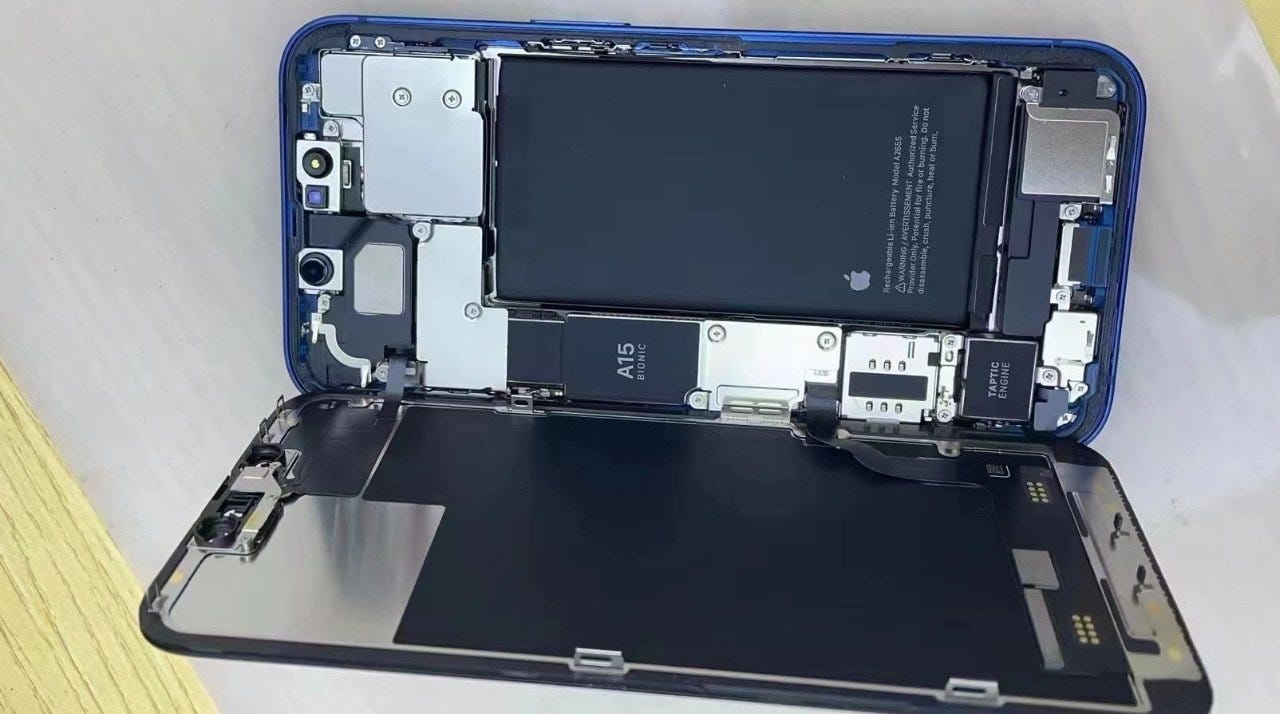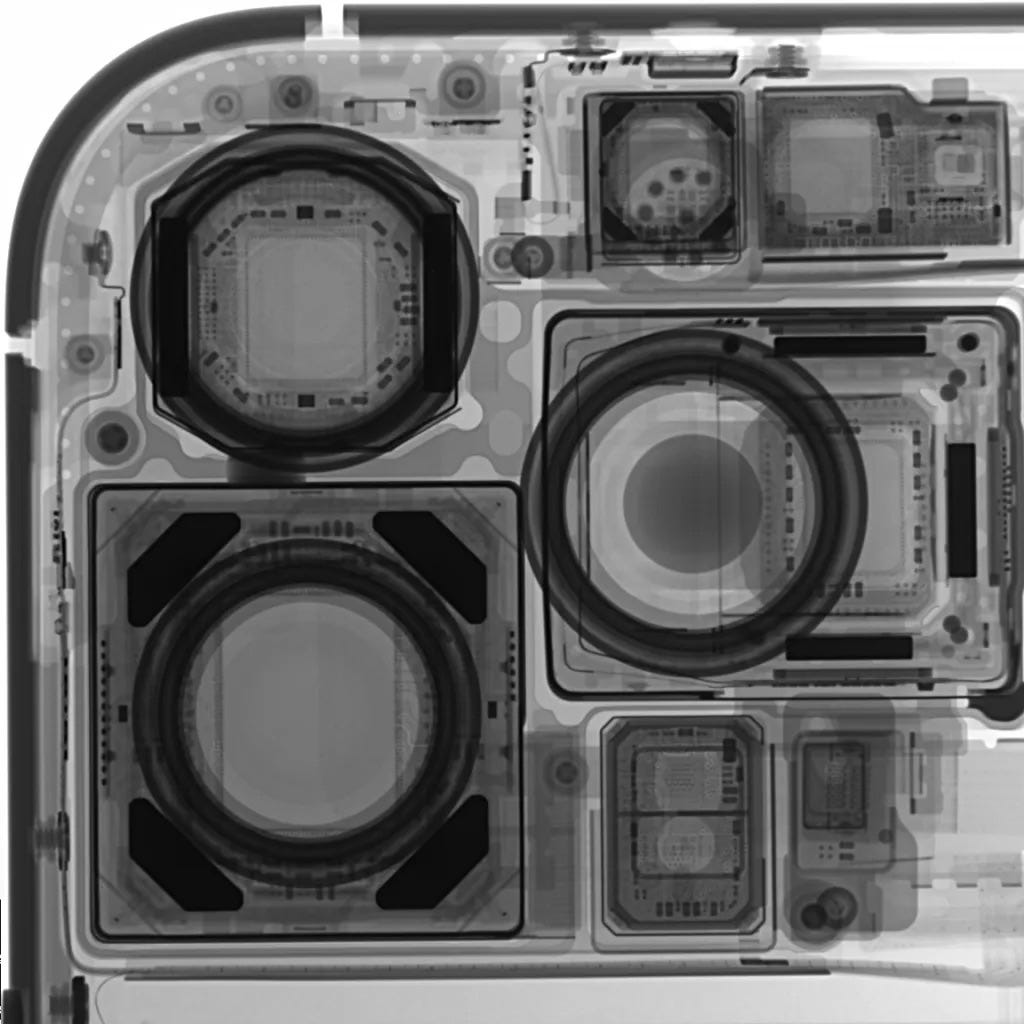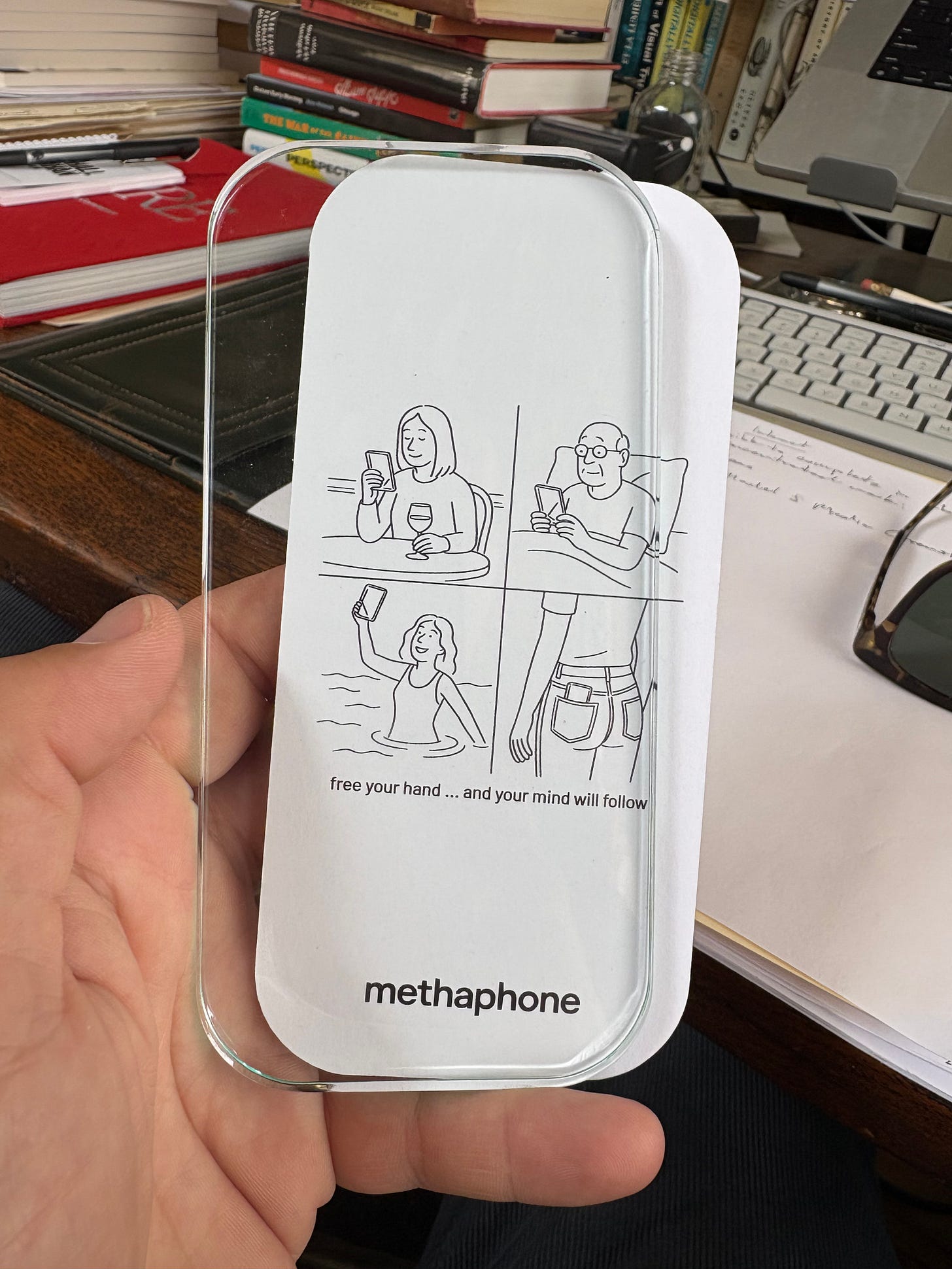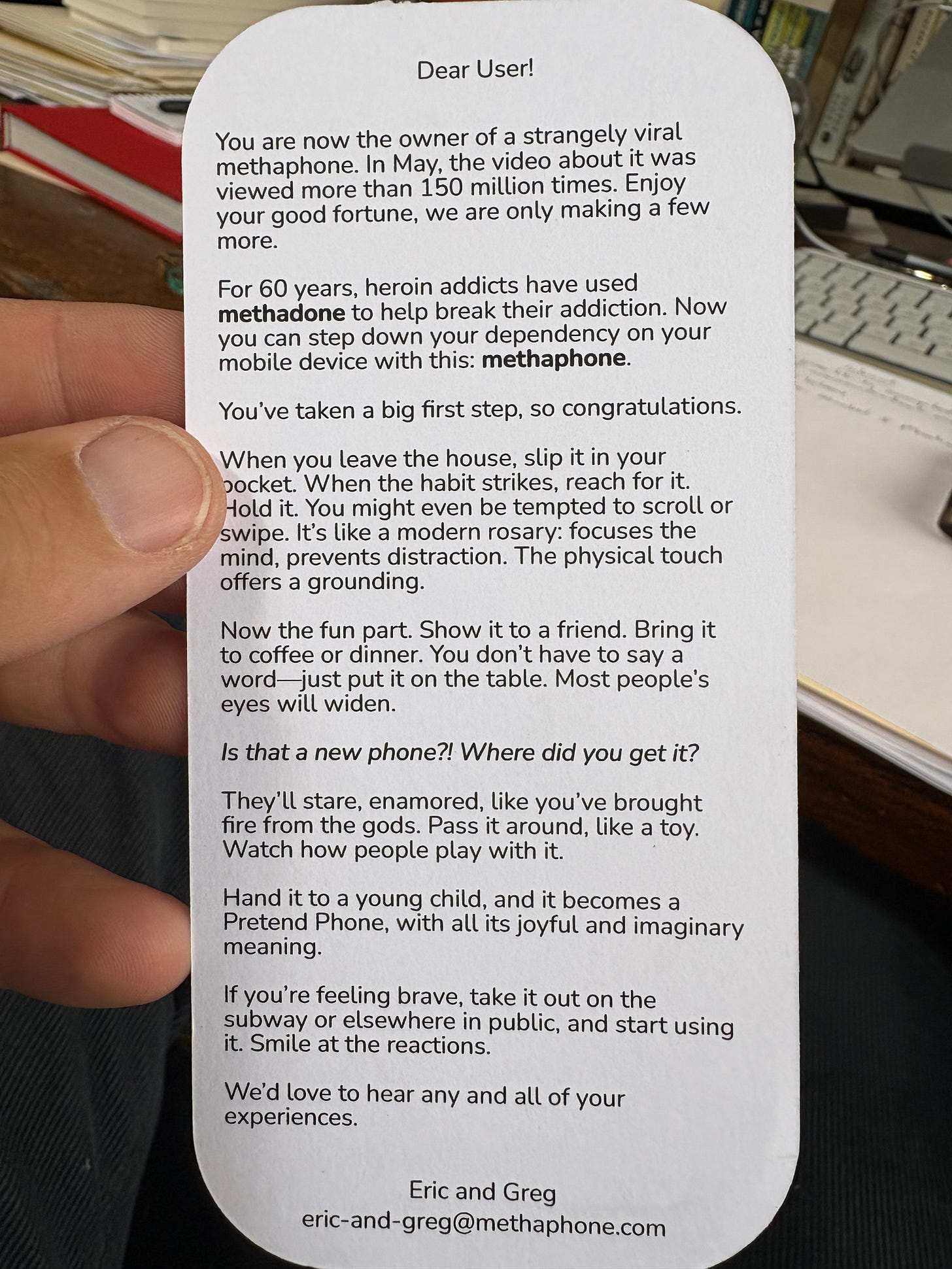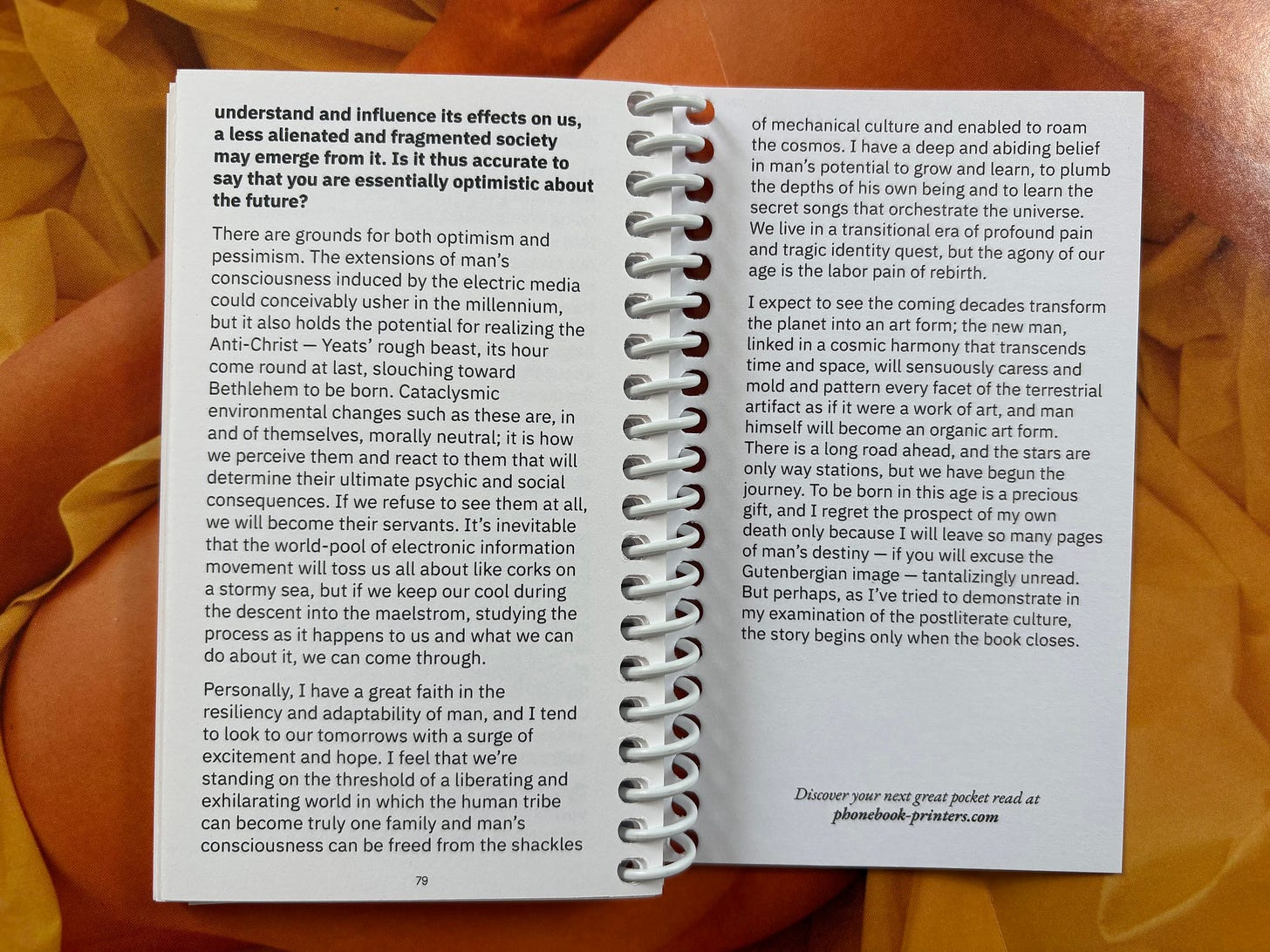Is that an anti-environment in your pocket?
A different kind of hardware, a different kind of review.
I received the most remarkable package in the mail this week: A ‘Methaphone’ and a pocket-size printing of Marshall McLuhan’s 1969 Playboy interview. Looking at them, playing with them, thinking about them, I realized that in a sense one is the form without the content, the other the content without the form.
With the Methaphone you have the form of the phone without the function, the content. Here the user is nakedly the content.
With the pocket Playboy interview, you have the words without the pictures, the copy without the bodies, the ideas without the ads.
The remarkable, poetic, beautiful thing is that both of these items arrived in the same package.
What I love most about Methaphone is that it is a piece of antienvironmental or counterenvironmental design, to coin a term and hopefully create a movement.
It is in a sense satirical.
“Environment used as probe or art object is satirical because it draws attention to itself.” [‘The Relation of Environment to Anti-Environment,’ p.3]
It is designed to draw your attention toward things you normally ignore, to the effects of technology. Most technology is designed to have you ignore these things. As Marshall McLuhan wrote about advertising and advertisers in 1951, “to generate heat not light” is their object, that is, to engage and provoke action not reflection, occupation not illumination. To generate heat not light.
But the Methaphone draws attention to the absurdity of stroking a piece of glass with your thumb mindlessly at every opportunity. To use the Methaphone in public while in line for a latte feels ridiculous to the user and looks ridiculous to the observer, as this viral TikTok demonstrates. And what you might learn from the experience is that whether it’s an iPhone in your hand or a Methaphone, it’s equally ridiculous — just one has become normal, accepted, taken for granted, and therefore invisible. It has become environmental.
And so the Methaphone arrives as a welcome anti-environment.
“…the environment as it presents itself for human attention and action… the phenomenon of the imperceptibility of the environment as such… The ground rules, the pervasive structure, the overall pattern eludes perception except insofar as there is an anti-environment or a counter-situation constructed as a means of direct attention.” [‘The Relation of Environment to Anti-Environment,’ p.1]
Marshall McLuhan wrote an essay in 1965 called ‘The Relation of Environment to Anti-Environment’ where he discusses the limited nature of human perception, and how as we become accustomed to things, we take them for granted, and they in effect disappear. They become part of our environment. Because environments are complex things, dynamic processes, and because out attention is finite, we prioritize some things and ignore many more. We ignore our breath and heart rate and most of the functions of our body, unless something happens to draw our attention to it—like how I just pointed it out, you might have even for a brief micro second checked in with your breath and heart rate. We don’t notice the internet signal or the electricity until there’s a disruption. And we do this because we have a limited amount of attention and many demands on it. So we prioritize things which need our direct attention.
Environment:
“But what I meant by the message had been also referred to as the massage or the changes and the re-arrangements of time and energy and space in our daily lives, resulting from this new service. Oh yes, that’s another way of saying that a medium creates a total environment of services, and many are disservices. But a medium creates a huge new environment of services and this is the message of the medium." [Marshall McLuhan in discussion with Eric McLuhan, working on a revision of 'Understanding Media: The Extensions of Man'. Transcript dated August 11, 1971.]
So ‘the environment is the message’ is another but less poetic way of saying ‘the medium is the message’ because ‘medium’ and ‘environment’ are synonyms.
An Anti-Environment is
“…a counter-situation constructed to provide a means of direct attention.” [‘The Relation of Environment to Anti-Environment,’ p.1]
Critically:
“The new medium as an environment creates new occupations. As an environment it is imperceptible except in terms of its content. That is, all that is seen or noticed is the old environment. The effects of the environment in altering the entire character of human sensibility and sensory ratios is completely ignored."
(I altered the quote to remove the references to TV and make it easier to relate to, say, AI. See the following image for the original quote)
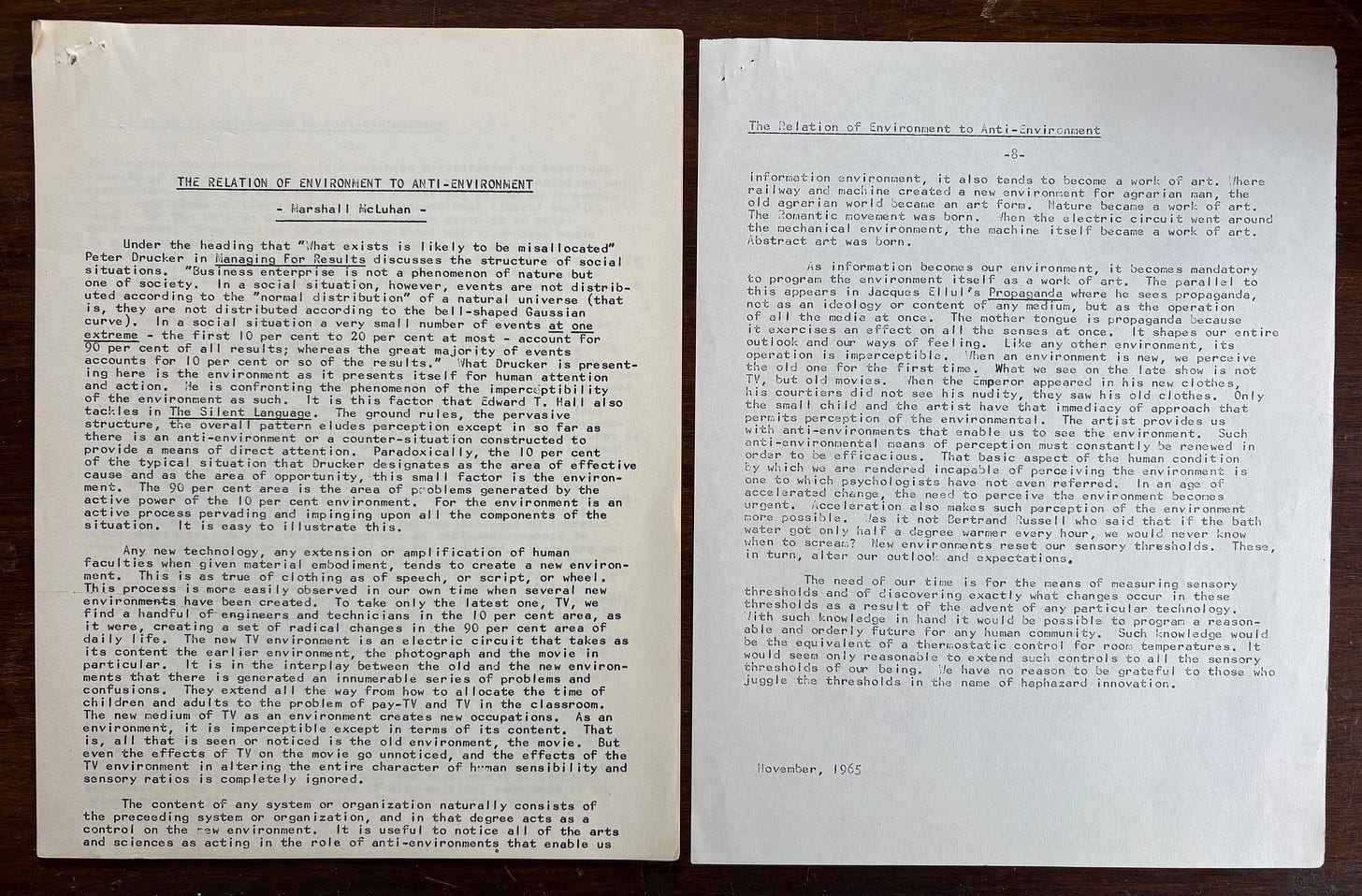
“We have designed schools as anti-environments to develop the perception and judgement of the printed word. There are no means of training provided to develop similar perception and judgement of the any of the new environments created by electric circuitry. This is not accidental.” [‘The Relation of Environment to Anti-Environment,’ p.2]
“It is useful to notice all of the arts and sciences as acting in the role of anti-environments that enable us to perceive the environment.” [‘The Relation of Environment to Anti-Environment,’ p.1-2]
What the creators of the Methaphone have done is create just this kind of ‘anti-environment or counter-situation’ to draw attention to things we do not notice or overlook because they have become assumed, taken for granted, normalized—environmental.
If you can think back and imagine a coffee lineup before smart phones… damn I’m old… what did we even do in lineups? Anyway, if you could go back in time and be in that lineup scrolling on your iPhone before iPhones and social media were ubiquitous (environmental) you would draw the same attention as the person in that viral TikTok video on a Methaphone.
I tried it out. I whipped it out at my mom’s place and began scrolling with my thumb. At first, her new tech radar lit up and she was very interested. She’s used to me showing up with weird tech stuff. I passed it to her after a minute and let’s say my mother was … not amused.
What if I pulled it out at my son’s hockey practice tonight rather than watch him shred? (Yes, it’s August, and yes, we live in Canada, my son plays AA, so we’re at the rink not the lake. If you’re looking to sponsor a kid’s hockey dreams and team, get at me). It would seem a better use of time to actually watch the lad. But that’s true whether I’m looking at my iPhone or the hunk of acrylic which is the Methaphone, despite what I might tell myself. If we’re honest with ourselves, in most cases computers are better on our desk than in our pockets. I’m seriously considering a Light Phone as my everyday carry. I want the useful functions without the junky temptations.
I’m going to make a radical claim and suggest that the best technology is not technology which disappears, as seems to be the goal of most design, but technology which makes the invisible parts of the environment appear. When did lack of friction become a goal, and who does it serve? Most times it’s not the user.
What are they hiding? Why are they hiding it? Cui bono?
We can’t do anything about something we can’t even see.
The biggest problem with the Methaphone, in fact it’s only weakness from my point of view, is that it arrives a little too late. Twenty years too late.
“The models of perception provided in the arts and sciences alike can serve as indispensable means of orientation to future problems well before they become troublesome.” [‘The Relation of Environment to Anti-Environment,’ p.3]
And this to me is where we are now. Things happen to fast to be able to wait twenty years to draw attention to something well after we can do very much about it. At this stage in human history, we need to figure out how to construct antienvironments or counterenvironments in the design stage of technology to get ahead of the undesirable effects before we cause them.
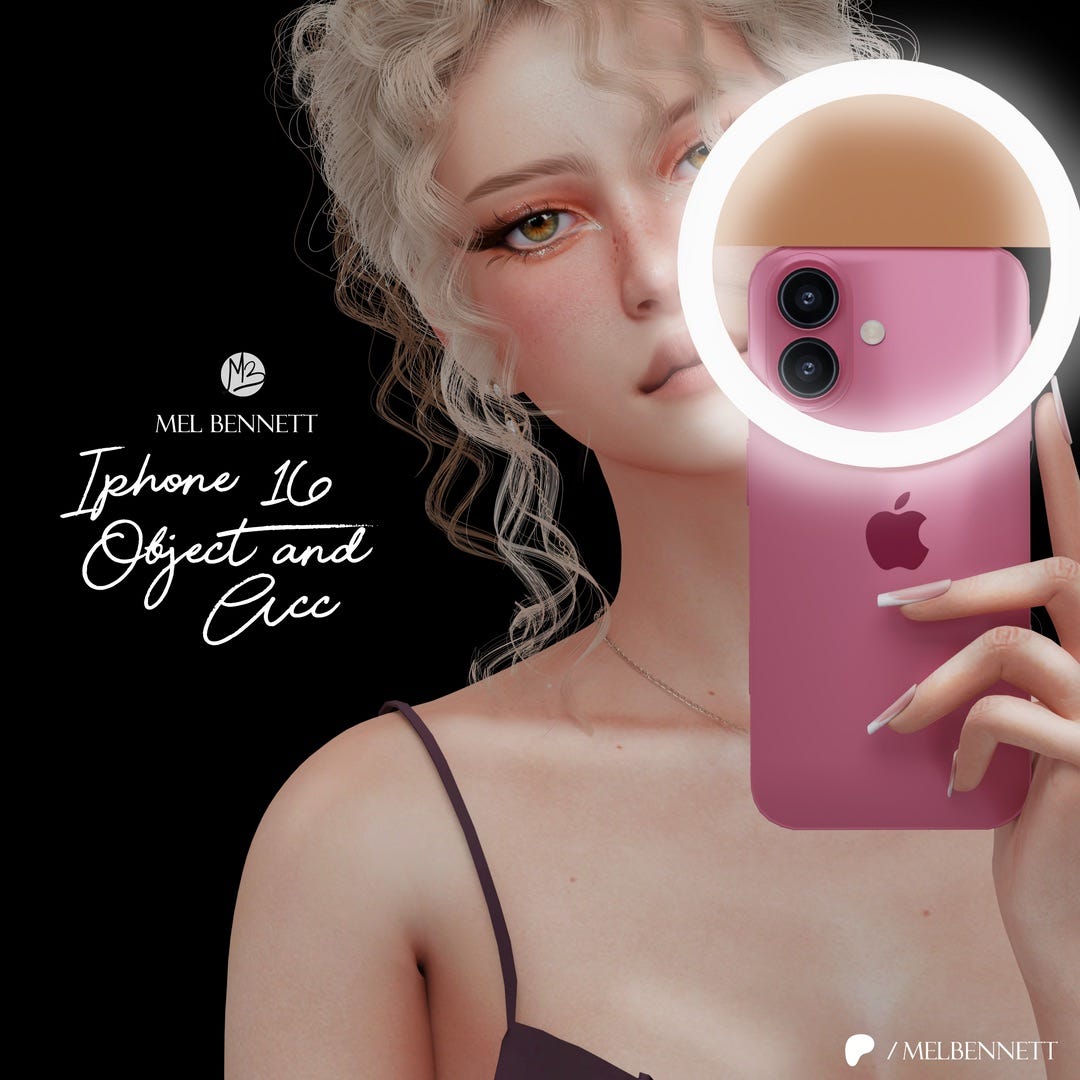
Marshall McLuhan’s March 1969 Playboy interview really deserves a separate post, so I’m going to do it that courtesy. It’s probably the best interview he gave in terms of its depth and comprehensiveness. It still stands up today. (It’s easy to find a pdf of it online, for example here.)
It’s a joke as old as the once-popular magazine itself that “Oh, I only read it for the articles.” And really the once-titillating nudity from those old Playboys is laughably tame compared to what you might pull up on your iPhone by accident or intent.
It seems appropriate to save the post about the interview for another day given that we’re talking about form, and besides, the medium is the message. Methaphone really drives that home. I’d nominate it for a ‘medium is the message’ award if there were one.
I think it likewise appropriate to give Marshall McLuhan the last word here, and use his last words from the 1969 Playboy interview.
Playboy: “Despite your personal distaste for the upheavals induced by the new electric technology, you seem to feel that if we understand and influence its effects on us, a less alienated and fragmented society may emerge from it. Is it thus accurate to say that you are essentially optimistic about the future?”
McLuhan:
Right?
“The story begins only when the book closes,”
or when we put the phone down, as the case may be.
Thanks for being here,
Andrew
Note: F*ck a paywall, all editions of The McLuhan Newsletter are free. But I have to make a living and am trying build an empire and to save the world, and that ‘aint free at all. I appreciate your financial support, as you are willing and able. Billionaires hmu.
Note: any errors are obviously intentional as proof of organic, rather than mechanic (AI) content. They are of course proof of humanity, not a result of lazy or proofreading. (Ok, mom?)



